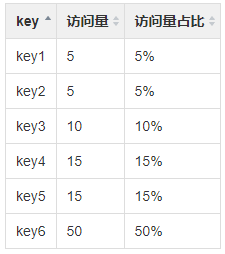高性能,高可靠的热点数据探测系统。热乎的分享文章参考:Caffeine如何变热?
架构如下:
组件介绍:
- Etcd:配置中心,用于服务发现和配置等。
- client:客户端SDK,用于数据收集上报和接收热key。
- Worker:用于接收客户端数据上报和热key计算。
- Dashboard:管理后台和数据展示。
调用流程:
- Worker启动后注册到etcd。
- 客户端通过etcd监视worker地址。
- Etcd通知客户端etcd变动。
- 客户端上报统计数据到worker。
- Worker收到统计数据计算热key。
- Worker将热key推送给客户端。
- Worker将热key推送给Dashboard。
特性:
-
高性能:内置高性能缓存库caffeine实现数据缓存和统计。
16核32G内存的worker实例支持每秒59万key探测。
-
高可用:任何组件宕机或异常不影响接入业务。
-
准确性:采用sentinel滑窗计数,防止时间影响速率。
-
实时性:秒级发现推送热点数据。
-
扩展性:支持大规模接入,支持水平扩容。
HotCaffeine数据采用redis存储(下载链接),故redis务必开启持久化机制。
redis安装配置步骤略去,安装好后初始化如下数据:
hset user admin@admin.com "{"userName": "admin@admin.com", "pwd":"hQ6xcq67rh0nn/0sl82paQ==", role:"ADMIN"}"
注意etcd需要为V3版本,下载链接参考,etcd安装配置步骤略去。
etcd的安全模型如下:
HotCaffeine采用如下鉴权保障安全性:
- 针对客户端,需要单独的用户名和密码,但是他们共同拥有同样的角色,就是client,而client对资源/hotcaffeine/只有只读权限。 注:如果每个客户端都具有单独的角色,设计过于复杂,对于内网应用来说,只读安全性应该够了。后续如果需要精细控制,客户端无需任何修改,在etcd中可以为每个业务端再分配单独的角色。
- 针对worker,由于是内部应用,单独建立一个worker的角色,对资源/hotcaffeine/具有读写权限。
- 针对dashboard,由于是内部应用,需要给各个用户赋权,故其拥有root用户和权限。
etcd权限初始化如下:
将etcd-auth.sh放到etcd安装目录下,执行。root密码输入H&O%T=C9AFF]。worker密码输入=+WK%&#*。
或者直接执行com.hotcaffeine.common.etcd.EtcdAuthInit.java
用户名:admin@admin.com 密码:admin
-
缓存规则
- name:缓存名,每条key规则都需要关联一个缓存规则。
- duration:缓存过期时间,单位:秒。
- size:缓存大小。
-
key规则:
[ { "key":"*", "prefix":false, "cacheName":"default", "interval":1, "threshold":100, "enableLocalDetector":false, "topkCount":100, "useTopKAsHotKey":false } ]- key:精准匹配或前缀匹配名,*表示为默认规则。
- cacheName:缓存规则的名字。
- prefix:是否为前缀匹配。
- interval:滑动窗口时间间隔。
- threshold:在interval达到threshold即变为热点数据。
- enableLocalDetector:是否开启本地检测。
- topkCount:topk的数量。
- useTopKAsHotKey:是否使用topk作为热点数据。
缓存规则和key规则是一对多的关系。
精准匹配:即直接在代码中使用key规则中配置的key,详情请参考客户端使用。
前缀匹配:如果缓存的key是有规律的,可以使用前缀匹配,假如有如下key规则:
api:user:vip
api:user
可以针对这两种key设置不同的规则,前缀匹配会优先匹配较长的串,例如:
api:user:vip:1234会优先匹配api:user:vip对应的规则,而不是api:user对应的规则。
该模块可以查看各个规则的热点数据,默认只保留1万条,如下:
点击热key名可以查看热key在各个客户的实例对应的值:
该模块用于辅助业务发现key的分布情况,用于设置缓存大小和过期时间等重要指标,以满足某个命中率。
下面举个具体的例子来说明一下,假设业务系统在某段时间内共有如下6个key访问,访问总量为100:
那么,如果这段时间内,key6在缓存中的话,命中率就能达到50%。而key1和key2在缓存中的话,命中率仅为10%。
根据这个简单的例子,来看下调用量分布:
- 左边第一列是调用量,也就是上面那个例子中说的访问量。
- 第二列是key的数量,根据这列可以大概知道key的多少(非重复),进而可以设置缓存大小。
- 第三列是调用量占比,比如 以第二行的数据为例来说明一下:
- 调用量=2的key有944个,那么调用量为2的key的总调用量为1888,它占本次统计的总调用量的比例为17.95%。
- 也就是说如果把调用量为2的key都缓存下来,需要缓存大小为944,命中率为17.95%。
- 第四列是key的生存时间数据,可以参照个这个数据设置缓存的过期时间。
注意: 这些统计不包含已经变热的数据,建议业务方一开始把热点阈值调大,让所有的key都上报,再参考调用量分布调整缓存大小和过期时间。
默认hotkey探测热键采用的是阈值,即达到某个阈值即认为变热了。
topk作为阈值规则的补充,从另外一个维度来选择热键,它的度量指标是访问量,即访问量最高的k个键作为热键。
同样,topk统计的数据不包含已经变热的数据,默认每分钟进行一次数据统计。
此曲线图纵坐标轴含义是topk的访问量与总量的比例,即可以认为,此段时间内,如果将这些topk的键缓存下来,命中率可以达到此比例。
鼠标放到曲线点上展示的是具体的数据情况。当点击该曲线点时,可以看到具体的topk数据,如下:
这里的调用量是指从key上报开始,如果后续持续的有数据上报会持续统计。
存活时间是指从key上报开始,至统计时的时间
点击key的名字即可看到该key实时的滑动窗口数据,如下:
各项指标含义如下:
- 总时间窗口:在key规则里配置的滑动窗口时间。
- 时间窗口长度:每个时间窗口是多少ms。
- 默认如果总时间窗口为1秒,有2个滑动窗口。
- 两秒钟有四个滑动窗口。
- 3秒及以上每秒一个滑动窗口。
- 最多不能超过10秒。
- 生存时间:key从创建到目前一共存在的时间。
- 活跃时间:类似生存时间,在每分钟统计topk时此key的滑动窗口没有有效的量将会把活跃时间置0。
- 总调用量:key从创建导目前一共被访问的次数。
滑动窗口:
- 滑动窗口默认1秒钟拉取一次数据,最左边为旧的窗口,最右边为最近的窗口。
- 窗口虚线表示该窗口已经废弃(超过有效窗口时间的为废弃)。
- 窗口红色实线表示该窗口有效,窗口内文字如果红色加粗,表示该窗口正在计数。
<dependency>
<groupId>com.hotcaffeine</groupId>
<artifactId>annotation</artifactId>
<version>1.0</version>
</dependency>
<appender name="hotcaffeine" class="ch.qos.logback.core.rolling.RollingFileAppender">
<file>${LOGS_DIR}/hotcaffeine.log</file>
<rollingPolicy class="ch.qos.logback.core.rolling.TimeBasedRollingPolicy">
<fileNamePattern>${LOGS_DIR}/otherdays/hotcaffeine.log.%d{yyyy-MM-dd}</fileNamePattern>
<maxHistory>10</maxHistory>
</rollingPolicy>
<encoder>
<pattern>%d{yyyy-MM-dd HH:mm:ss.SSS} {%thread} %-5level %logger{50}-%L - %msg%n</pattern>
</encoder>
</appender>
<logger name="hotcaffeine" level="info" additivity="false">
<appender-ref ref="hotcaffeine" />
</logger>
HotCaffeineDetector hotCaffeineDetector = new HotCaffeineDetector.Builder().endpoints("http://127.0.0.1:2379").appName("core.user.hotcaffeine").build();
hotCaffeineDetector.start();
HotCaffeine hotCaffeine = hotCaffeineDetector.build();
/**
* 满足热点阈值的key会返回true
*/
hotCaffeine.isHot(key)
/**
* 此种使用方式将会把redis里满足热点阈值的数据会存储在HotCaffeine中
*/
public Video get(String key){
return hotCaffeine.getValue(key, k->{
return redis.get(k);
});
}
当key变成热键时,支持异步的方式进行通知,需要实现如下接口:
public interface IKeyListener {
/**
* key变热时通知,只通知一次,不会重复通知
* 如果需要缓存hot(String key)的返回值,请将needCacheValue返回为true
* 尽量一秒内返回
* @param key
* @return 需要缓存的值
*/
public Object hot(String key);
/**
* 是否需要缓存值
* @return 默认缓存
*/
default boolean needCacheValue() {
return true;
}
}
同时需要在构建HotCaffeine的时候将其传入,例如:
HotCaffeine hotCaffeine = hotCaffeineDetector.build(videoKeyListener);
如果想将不同的数据存储在不同的缓存中,例如用户数据存储在user的缓存,视频数据存储在video的缓存,可以按照如下步骤操作:
-
在缓存规则中配置两条记录:
{ "name":"user", "duration":600, "size":1000 }, { "name":"video", "duration":60, "size":20000 } -
在key规则中配置两条规则:
{ "key":"video", "prefix":false, "cacheName":"video", "interval":1, "threshold":10 }, { "key":"user", "prefix":false, "cacheName":"user", "interval":5, "threshold":10 } -
在代码中构建不同的实例,即可使用:
HotCaffeine videoHotCaffeine = hotCaffeineDetector.build("video"); HotCaffeine userHotCaffeine = hotCaffeineDetector.build("user");用videoHotCaffeine的数据会执行video的key规则。
用userHotCaffeine的数据会执行user的key规则。
前缀匹配的代码使用如下:
HotCaffeine prefixHotCaffeine = hotCaffeineDetector.buildPrefix();
即使用prefixHotCaffeine会使用key规则中prefix为true的所有规则。
HotCaffeine使用了micrometer进行了各种维度的数据统计,包括如下:
-
缓存命中率、大小、淘汰等:
# HELP cache_eviction_weight The sum of weights of evicted entries. This total does not include manual invalidations. # TYPE cache_eviction_weight gauge cache_eviction_weight{cache="core.user.hotcaffeine",} 0.0 cache_eviction_weight{cache="syncRequest",} 0.0 cache_eviction_weight{cache="recentCache",} 0.0 # HELP cache_puts_total The number of entries added to the cache # TYPE cache_puts_total counter cache_puts_total{cache="core.user.hotcaffeine",} 1.0 cache_puts_total{cache="syncRequest",} 0.0 cache_puts_total{cache="recentCache",} 1.0 # HELP cache_gets_total the number of times cache lookup methods have returned an uncached (newly loaded) value, or null # TYPE cache_gets_total counter cache_gets_total{cache="syncRequest",result="miss",} 0.0 cache_gets_total{cache="recentCache",result="hit",} 1.0 cache_gets_total{cache="syncRequest",result="hit",} 0.0 cache_gets_total{cache="core.user.hotcaffeine",result="hit",} 0.0 cache_gets_total{cache="recentCache",result="miss",} 2.0 cache_gets_total{cache="core.user.hotcaffeine",result="miss",} 1.0 # HELP cache_evictions_total cache evictions # TYPE cache_evictions_total counter cache_evictions_total{cache="core.user.hotcaffeine",} 0.0 cache_evictions_total{cache="syncRequest",} 0.0 cache_evictions_total{cache="recentCache",} 0.0 # HELP cache_size The number of entries in this cache. This may be an approximation, depending on the type of cache. # TYPE cache_size gauge cache_size{cache="core.user.hotcaffeine",} 0.0 cache_size{cache="syncRequest",} 0.0 cache_size{cache="recentCache",} 1.0 -
netty流量:
# HELP hotcaffeine_netty_traffic # TYPE hotcaffeine_netty_traffic gauge hotcaffeine_netty_traffic{group="read",} 492.0 hotcaffeine_netty_traffic{group="write",} 203.0 -
key发送接收:
# HELP hotcaffeine_send_keys_total # TYPE hotcaffeine_send_keys_total counter hotcaffeine_send_keys_total 1.0 # HELP hotcaffeine_receive_keys_total # TYPE hotcaffeine_receive_keys_total counter hotcaffeine_receive_keys_total 2.0 # HELP hotcaffeine_deal_keys_total # TYPE hotcaffeine_deal_keys_total counter hotcaffeine_deal_keys_total 2.0 -
客户端连接数量:
# HELP hotCaffeine_app # TYPE hotCaffeine_app gauge hotCaffeine_app{app="core.user.hotcaffeine",} 1.0
worker指标地址:http://127.0.0.1:9998/actuator/prometheus
dashboard指标地址:http://127.0.0.1:8888/actuator/prometheus
客户端如果是boot项目,也会自动暴露,这些指标可以使用prometheus+grafana进行收集展示。












